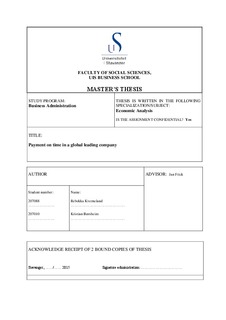| dc.description.abstract | The research questions above are answered through a literature review, an action research and some key analyses. The first part of this paper contains a corporate overview, outlines the background and history and then presents the current situation for the company. A history full of mergers and fast development builds up an understanding of Schlumbergers current situation. Under the presentations of today’s Sclumberger the reader gets insight in how the company is organized and in the processes relevant in this case study.
The second part is a theoretical approach about payment on time and payment terms, where the writers state out important things all companies should consider when working on these issues. This is followed by a chapter about the methods used in the case study, where the writers amongst other points out strengths and weaknesses with the data used.
The following chapter give some of the main explanations for why Sclumberger does not manage to pay all their invoices within due date.
The consultants conducted an action research where they worked on improving payment terms from Schlumberger’s suppliers. The way this was done, the weaknesses with the systems and processes used are presented. This part of the research helped set the standard for how to go about when contacting suppliers to ask for improved payment terms. This was partly done through an analysis stating the direct financial cost of fees and interest and comparing this to Schlumberger`s weighted average cost of capital. This resulted in working with the suppliers which Schlumberger spends most money on, not the supplies which Schlumberger pay the highest amount of fees and interest to due to overdue payments. Some suppliers were contacted and asked for better payment terms, while some already had agreed to better terms, but an update was needed in the Schlumberger’s systems. The researchers also did some calculations to estimate the value of these changes they did.
The researchers used Schlumberger’s systems and sent 269 requests, which involved 223 different suppliers. They were able to track the changes actually implemented, and could then state what is the strengths and weaknesses with the systems and the work flows used today. It was found that over 20% of the requests sent out went to ERP sites not used by the Geomarket this research was done in, which is Norway and Denmakr. And therefore these 20% will not affect their payment on time for Norway and Denmark. POT for NOR. The cause of this and other weaknesses is explained, and the researchers provide some suggestions of changes needed for the systems and the processes to be more efficient.
The next part is an analysis done on all invoices paid by Schlumberger in 2014. By running several regressions, investigating distributions and visualizing effects, the researchers increases the understanding of what affects payment on time. Based on this, the researchers give advices on what the company should focus on to be able to reach their goal for payment on time for 2015. Ultimately increasing payment on time from 77.7% in Q4 2014 to 81.6% in Q4 2015. In this part of the paper the researchers show that in terms of explaining and improving payment on time the logged data of paid invoices is of high value.
It is shown that for Schlumberger it is of surprisingly high value to get the credit time to start running from invoice received date instead of from invoice date. This change in date calculation has the potential to increase the time available to pay the invoices with around seven to eight days. The credit time had a surprisingly low β coefficient of approximately 0.62 days extra time to process the invoice for one day extra credit time. Comparing the date calculation with credit time results in the interesting fact that when working with improved payment terms the Sclumberger workers should weight invoice calculation from receipt date approximately with the same weight as 11-13 days extra credit time. Thus with this data and supplementary data the researchers estimate that the possible improvement in payment on time coming from better payment terms is estimated at be 1.2% points in 2015.
The use of purchase order is also highlighted as a good way of improving payment on time. By investigating the usage of purchase order, the researchers found it reasonable to say that the possible effect on payment on time for 2015 from increased use of purchase order can be estimated to 0.4%. It is also pointed out that the Supplier Portal, an IT solution for invoices sent to Sclumberger, is not solely improving payment on time but possibly even harming payment on time. This is also very surprising.
With these findings and other supplementary findings it is concluded that for Sclumberger it is not sufficient to continue in the same manner of improving payment on time to reach the key performance objective for payment terms in 2015, but the company needs to consider new methods away from payment terms and use of purchase order. Other possible improvements were then looked into, like shortening the last part of the invoice payment process, called “payment lead time”. Here it was found that for all the invoices stated as “ready to pay” before due date, only missing a last control audit, 8.4% were not paid on time. This should be further investigated, and the researchers estimate the possible improvement on payment on time from this to be approximately 4% points. If Slb manages to shorten the time spent in payment lead time in 2015, and also reaches the goals set for improved payment terms and increased use of purchase order, the key performance objective for payment on time in 2015 should be more than reached. | nb_NO |
